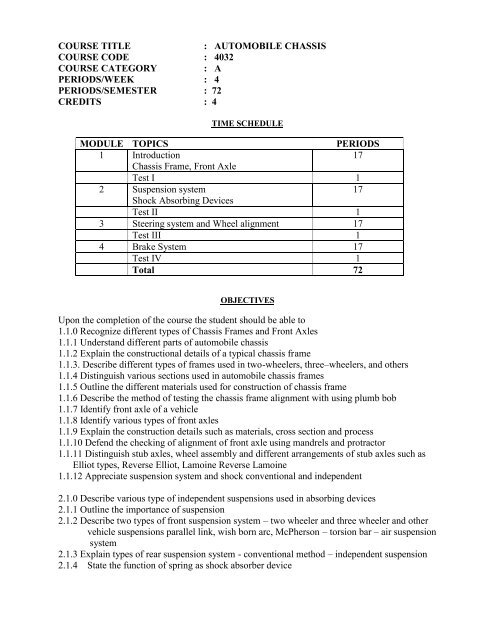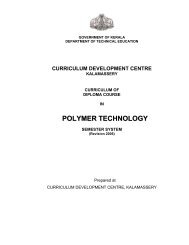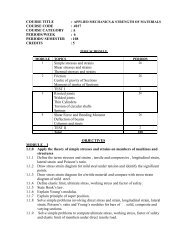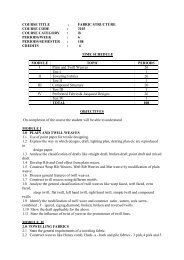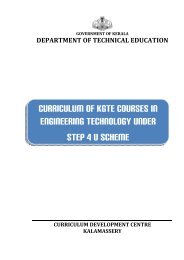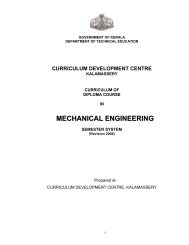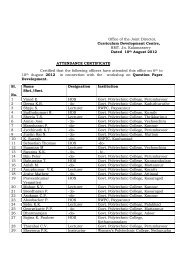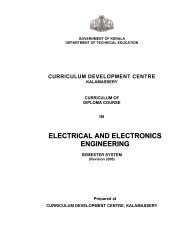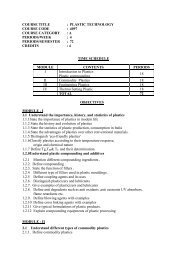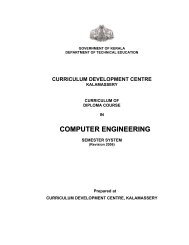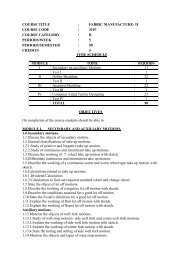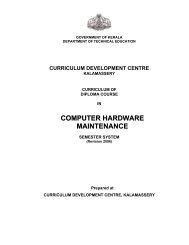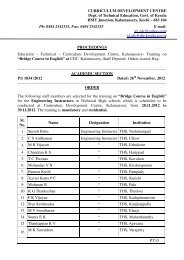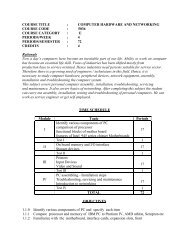COURSE TITLE : AUTOMOBILE CHASSIS COURSE CODE : 4032 ...
COURSE TITLE : AUTOMOBILE CHASSIS COURSE CODE : 4032 ...
COURSE TITLE : AUTOMOBILE CHASSIS COURSE CODE : 4032 ...
You also want an ePaper? Increase the reach of your titles
YUMPU automatically turns print PDFs into web optimized ePapers that Google loves.
<strong>COURSE</strong> <strong>TITLE</strong>: <strong>AUTOMOBILE</strong> <strong>CHASSIS</strong><strong>COURSE</strong> <strong>CODE</strong> : <strong>4032</strong><strong>COURSE</strong> CATEGORY : APERIODS/WEEK : 4PERIODS/SEMESTER : 72CREDITS : 4TIME SCHEDULEMODULE TOPICS PERIODS1 Introduction17Chassis Frame, Front AxleTest I 12 Suspension system17Shock Absorbing DevicesTest II 13 Steering system and Wheel alignment 17Test III 14 Brake System 17Test IV 1Total 72OBJECTIVESUpon the completion of the course the student should be able to1.1.0 Recognize different types of Chassis Frames and Front Axles1.1.1 Understand different parts of automobile chassis1.1.2 Explain the constructional details of a typical chassis frame1.1.3. Describe different types of frames used in two-wheelers, three–wheelers, and others1.1.4 Distinguish various sections used in automobile chassis frames1.1.5 Outline the different materials used for construction of chassis frame1.1.6 Describe the method of testing the chassis frame alignment with using plumb bob1.1.7 Identify front axle of a vehicle1.1.8 Identify various types of front axles1.1.9 Explain the construction details such as materials, cross section and process1.1.10 Defend the checking of alignment of front axle using mandrels and protractor1.1.11 Distinguish stub axles, wheel assembly and different arrangements of stub axles such asElliot types, Reverse Elliot, Lamoine Reverse Lamoine1.1.12 Appreciate suspension system and shock conventional and independent2.1.0 Describe various type of independent suspensions used in absorbing devices2.1.1 Outline the importance of suspension2.1.2 Describe two types of front suspension system – two wheeler and three wheeler and othervehicle suspensions parallel link, wish born arc, McPherson – torsion bar – air suspensionsystem2.1.3 Explain types of rear suspension system - conventional method – independent suspension2.1.4 State the function of spring as shock absorber device
2.1.5 Explain different types spring used in automobiles - leaf and coil springs2.1.6 Describe different type of leaf springs used in Automobiles, quarter elliptic, half elliptic,three quarter elliptic, cantilever, helper spring2.1.7 Identify spring shackles and pins and their functions2.1.8 State the function of shock absorbers as vibration damper2.1.9 Demonstrate different types of shock absorbers – hydraulic, direct acting and indirectacting2.1.10 Explain air suspension and hydro – elastic suspension3.1.0 Analyse the parts and working of steering system3.1.1 Describe the steering system Define steering geometry and directional stability and studythe principles of steering system, a clear time – Davis fifth wheel steering3.1.2 Predict instantaneous center and turning angle3.1.3 Explain different types of steering gas boxes – worm and roller, worm and sector, recirculatingballl type, rack and pinion3.1.4 Distinguish different arrangements of steering linkages – and their components such as tierod, tie rod ends3.1.5 Explain power steering and its types, integral and linkage type3.1.6 Defend collapsible type steering column3.1.7 Analyse wheel alignment – castor, camber, king pin inclination and toe – in and toe – out4.1.0 Comprehend the details of braking systems used in automobiles4.1.1 Describe the function of the brake and brake system4.1.2 Explain type of brakes and braking system – mechanical, hydraulic, pneumatic servobrake system, air brake – vacuum brake, fail safe brake, dual brake, and anti-lock brakesystem. Drum and disk brake system – internal expanding and bend brake systems4.1.3 Reproduce the layout of break system4.1.4 Explain different types, working principle of master cylinder, wheel cylinder and brakeshoe4.1.5 Explain constructional details and working of components of air brake4.1.6 Describe servo brake, types of servo brakes, vacuum and air working of servo brakes4.1.7 Explain mechanical brake and its types of arrangements4.1.8 Describe constructional details and working of disc brake4.1.9 Describe fail safe brake, dual brake and anti lock brake system4.1.10 State function and different arrangements of hand brake4.1.11 Explain application and working of exhaust brake4.1.12 Defend testing of brakes and brake efficiencyCONTENT OUTLINEMODULE – IChassis -Introduction, Constructional details, Types of frame. Frame for 2 wheeler,3wheelers,and 4 wheeler , frame sections, bumbers, sub frames. Materials used, Testing ofchassis -Front Axle- Introduction, Types – dead & live axle, Construction – material – crosssection-Checking the alignment of front axle, Stub axle – different arrangements.MODULE - IIIntroduction to Suspension systems, Types of front suspension for Two, three & four wheeler
Air suspension, Hydro-elastic suspension.Rear Suspension system, Types-.Introduction to springs and Shock absorbing devices, Types leafcoil, springs & their arrangements, Helper spring, Spring shackle – shackle pin , Telescopic typeShock – absorber, Hydraulic, gas filled type, Twin tube type, Basic suspension movementspitching,bouncing, rolling etc.
MODULE – IIIIntroduction to Steering system & steering geometry, Principles of steering, Ackerman , Davisfifth wheel , Steering gear box – types, Worm & roller, worm & sector, Re-circulating ball,Rack & pinion, Steering linkages – arrangement – componentsPower steering – integral – linkage type, Collapsible type steering columnWheel alignment –Factors affecting wheel alignment.MODULE – IVIntroduction to Brake Systems , principle of operation, weight transfer principle, types of brakes–mechanical, hydraulic, pneumatic, servo brake, Air brake – vacuum brake – fail safe brake – dualbrake – anti lock brake, Drum and disc brake system – Internal expanding and externallycontracting- Layout of brake system, mechanical Components, hydraulic – master cylinder, types– working principle – wheel cylinder – brake bleeding, brake shoe. Air brake – constructiondetails – working – details components – servo brakes -working of servo brake – types, vacuumand air - disc brake – constructional details and working of engine exhaust brake –testing ofbrake brake efficiency.REFERENCES1. Automobile Chassis & body - P.L.Kohli2. Automobile Engg - Kirpal Singh3. Automotive Chassis - P.M.Holdt4. Automobile Engineering - Anil Chhikara5. Automotive technology - Aehell


